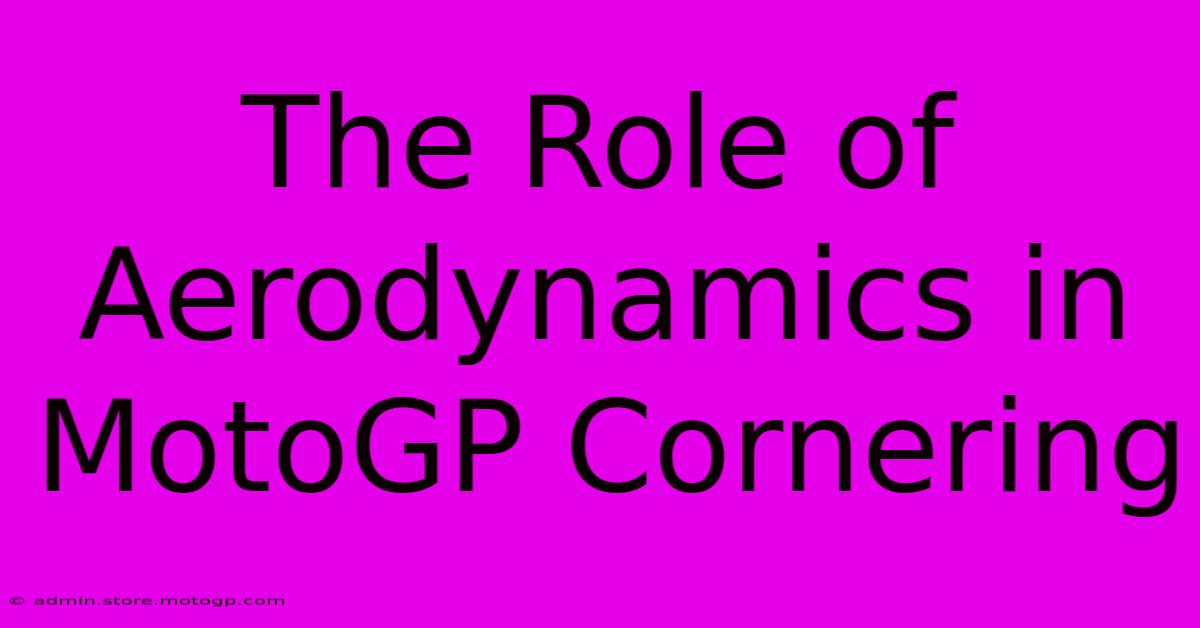The Role Of Aerodynamics In MotoGP Cornering

Table of Contents
The Role of Aerodynamics in MotoGP Cornering
MotoGP racing is a relentless pursuit of speed and precision, and cornering forms a crucial aspect of this high-octane battle. While rider skill and machine mechanics play significant roles, the often-overlooked element of aerodynamics significantly impacts a rider's ability to navigate bends at breakneck speeds. This article delves into the intricate relationship between aerodynamics and cornering in MotoGP, examining how cleverly designed aerodynamic components contribute to achieving faster lap times.
Understanding Aerodynamic Forces in MotoGP Cornering
Cornering in MotoGP isn't simply about slowing down and turning; it's a dynamic interplay of forces. Aerodynamics, the study of air's behavior around moving objects, plays a vital role in generating these crucial forces. The primary aerodynamic forces influencing cornering are:
-
Downforce: This is the force pushing the motorcycle towards the track surface. Increased downforce enhances grip, allowing riders to lean the bike further into the turn without losing control. This is particularly important at high speeds where centrifugal force tries to pull the bike outwards.
-
Drag: This is the resistance the air presents to the motorcycle's movement. While drag generally slows down the bike, its impact on cornering is less direct than downforce. However, managing drag is still crucial for overall performance. Reducing drag can lead to higher top speeds on straights, giving riders a better advantage before entering corners.
-
Lift: This is the upward force acting against the motorcycle, the opposite of downforce. MotoGP bikes are designed to minimize lift, especially during high-speed cornering, as lift can reduce stability and traction.
Aerodynamic Components and Their Function
Modern MotoGP bikes are marvels of aerodynamic engineering. Several components work in concert to maximize downforce and minimize drag and lift:
-
Wings: These are arguably the most visible aerodynamic elements. These carefully sculpted wings generate significant downforce, particularly at higher speeds. Their design is constantly evolving, with teams experimenting with different shapes, sizes, and configurations to optimize performance in specific corners.
-
Fairings: The motorcycle's fairings are not just for aesthetics; they are meticulously designed to manage airflow around the bike. They channel air effectively, minimizing drag and turbulence.
-
Underbody Aerodynamics: This often-overlooked aspect is equally crucial. The design of the underbody influences how air flows beneath the motorcycle, generating additional downforce and further improving stability.
-
Front Fairing and Nose: These areas significantly influence air pressure and how the air interacts with the front wheel, impacting the bike’s front-end stability during corner entry and apex.
Optimizing Aerodynamics for Cornering Performance
Teams invest immense resources into optimizing a bike's aerodynamics for various corners on a track. This involves:
-
Computational Fluid Dynamics (CFD): CFD simulations help engineers model and analyze airflow around the motorcycle, enabling them to refine the design of aerodynamic components to enhance downforce and reduce drag.
-
Wind Tunnel Testing: This crucial step allows engineers to test their designs in controlled conditions, validating CFD simulations and making further adjustments.
-
Track Testing: Real-world testing is essential to gather data from different cornering scenarios and refine the aerodynamic setup for optimal performance. Rider feedback is invaluable in this process.
The Interplay of Aerodynamics and Rider Skill
While sophisticated aerodynamics play a crucial role, it is essential to remember that it's not the sole determining factor in cornering prowess. The rider's skill, including their ability to manage throttle, lean angle, braking, and body positioning, remains paramount. A skilled rider can maximize the benefits of the bike's aerodynamic design, extracting the most performance from the machine.
Conclusion: Aerodynamics – A Cornerstone of MotoGP Success
In the fiercely competitive world of MotoGP, marginal gains are highly sought after. Aerodynamics, once a secondary consideration, is now a pivotal aspect of bike design and race strategy. The meticulous design and optimization of aerodynamic components enable riders to tackle corners at unbelievable speeds, pushing the boundaries of what's possible. As technology continues to evolve, the role of aerodynamics in MotoGP cornering will undoubtedly become even more critical. The constant evolution and refinement of aerodynamic systems will continue to shape the future of MotoGP racing.

Thank you for visiting our website wich cover about The Role Of Aerodynamics In MotoGP Cornering. We hope the information provided has been useful to you. Feel free to contact us if you have any questions or need further assistance. See you next time and dont miss to bookmark.
Featured Posts
-
What Time Is The Sprint Race Locally
Feb 21, 2025
-
Racing Motor Bikes For Sale Designed For Speed
Feb 21, 2025
-
The Moto Gp Rider With The Most Determination
Feb 21, 2025
-
Motorcycle Racing Demystified A Comprehensive Guide To Race Types
Feb 21, 2025
-
Moto2 Bikes Designed To Thrill
Feb 21, 2025
